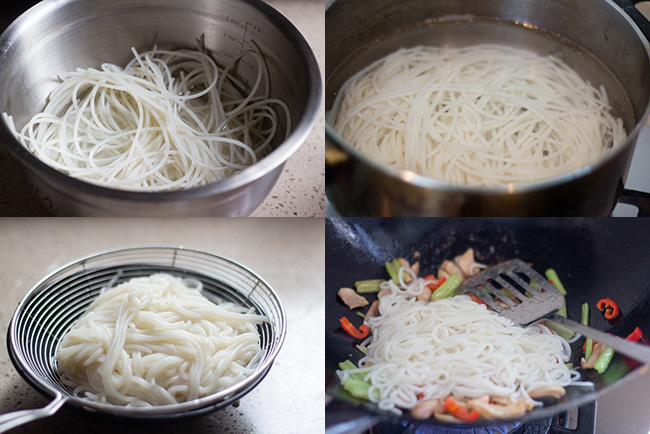Have you ever wondered how to recreate the delectable rice noodles you’ve enjoyed at your favorite Asian restaurants?
Look no further!
In this guide, we will unravel the secrets behind making these delicate strands of goodness.
Whether you’re a novice cook or a seasoned chef, we’ve got you covered.
Let’s dive into the art of making rice noodles and unlock a world of culinary possibilities!
how to make rice noodles
To make rice noodles, you can either buy pre-made fresh noodles from an Asian market or make them at home.
If you choose to make them at home, mix rice flour, tapioca starch or cornstarch, salt, and water to form a noodle mixture.
Add oil to the mixture and let it rest for 30 minutes.
Grease two cake tins with vegetable oil and pour a thin layer of the rice flour mixture into one tin.
Steam the mixture over boiling water for 3-4 minutes until set.
Brush the top of the noodle sheet with oil.
The homemade rice noodles are now ready to be used for stir-fried dishes or noodle soups.
Key Points:
- Rice noodles can be bought pre-made or made at home using rice flour, tapioca starch, salt, and water.
- If making at home, add oil to the noodle mixture and let it rest for 30 minutes.
- Grease two cake tins with oil and pour a layer of the mixture into one tin.
- Steam the mixture for 3-4 minutes until set.
- Brush the top of the noodle sheet with oil.
- Homemade rice noodles can now be used for stir-fried dishes or noodle soups.
how to make rice noodles – Watch Video
💡
Pro Tips:
1. Rice noodles, also known as rice vermicelli, originated in China around 2,000 years ago during the Han dynasty.
2. The traditional process of making rice noodles involves soaking, grinding, and steaming rice flour, and then rolling and cutting the dough into thin strips.
3. Rice noodles are naturally gluten-free, as they are made solely from rice flour, water, and sometimes tapioca flour or cornstarch.
4. Rice noodles are a popular staple in Southeast Asian cuisine. They are commonly used in dishes such as Pad Thai from Thailand and Pho from Vietnam.
5. Rice noodles are incredibly versatile and can be used in various dishes, including noodle soups, stir-fries, cold salads, and even dessert recipes like rice noodles with coconut milk and mango.
Buying Pre-Made Fresh Rice Noodles
Rice noodles are a staple in many Asian dishes, and buying pre-made fresh rice noodles from an Asian market can save you time in the kitchen. These noodles are freshly made and have a soft, slippery texture that is perfect for stir-fried dishes and noodle soups. Look for them in the refrigerated section of your local Asian market, usually near other fresh produce or tofu. These noodles are usually packaged in a sealed plastic bag or container to keep them moist and fresh. Simply follow the instructions on the packaging for cooking and enjoy the convenience of ready-to-use rice noodles in your cooking.
Homemade Rice Noodles For Stir-Fried Dishes Or Noodle Soups
Making your own homemade rice noodles can add a personal touch to your dishes. They are versatile and can be used in stir-fried dishes or in noodle soups. To make homemade rice noodles, you will need a few basic ingredients such as:
- Rice flour
- Tapioca starch or cornstarch
- Salt
- Water
These ingredients are often readily available in most grocery stores. By making your own rice noodles, you have control over the thickness and texture of the noodles, allowing you to customize them according to your preferences.
Preventing Rice Noodles From Sticking Together
One common issue when working with rice noodles is the tendency for them to stick together. To avoid this, it is essential to take certain precautions during the cooking process.
Before cooking the noodles, brush each layer with oil. This simple step will create a protective barrier that prevents the noodles from sticking together. Be sure to use a flavorless oil with a high smoke point, such as vegetable or canola oil.
Additionally, stir the rice mixture well before adding it to the pan. This will ensure that the ingredients are evenly distributed and blended, reducing the risk of clumps and sticking during cooking.
- Brush each layer of noodles with oil before cooking.
- Use flavorless oil with a high smoke point, such as vegetable or canola oil.
- Stir the rice mixture well before adding it to the pan.
“Brushing each layer of rice noodles with oil before cooking creates a protective barrier that prevents them from sticking together.”
Using Two Flat-Bottomed Pans For Faster Cooking
If you are making a large batch of rice noodles or are short on time, using two flat-bottomed pans can help speed up the cooking process. The flat-bottomed pans provide a larger surface area for cooking, allowing you to cook more noodles at once. When using two pans, ensure that both pans are of the same size and have flat bottoms to ensure even heat distribution. Place them on top of the boiling water in a wok or cooking vessel. The steam from the boiling water will help cook the noodles evenly and efficiently.
Ensuring Even Thickness By Leveling The Pan On Boiling Water
To achieve evenly cooked rice noodles with a consistent thickness, it is crucial to ensure that the pan is level on top of the boiling water. Uneven thickness can lead to some parts of the noodles being undercooked while others are overcooked. This can result in an unpleasant texture and taste.
Before pouring the rice liquid into the pan, make sure to:
- Fill the wok or cooking vessel with enough boiling water.
- Carefully place the pan on top of the boiling water.
- Adjust its position until it is level.
This will ensure that the rice noodles cook evenly throughout.
Tip: Properly leveling the pan is essential for achieving uniformly cooked rice noodles.
Stirring The Rice Mixture Well Before Cooking
Properly stirring the rice mixture before cooking is essential to create a smooth, well-blended noodle batter. Before adding the mixture to the pan, take the time to stir it well, ensuring that all the ingredients are fully incorporated. This will prevent any lumps or clumps from forming, resulting in a smoother and more uniform noodle sheet. Use a whisk or spatula to mix the rice flour, tapioca starch or cornstarch, salt, and water until you achieve a consistent texture. Be thorough in your mixing to ensure a successful outcome.
Mixing Rice Flour, Starch, Salt, And Water For The Noodle Mixture
The noodle mixture for homemade rice noodles consists of rice flour, starch (such as tapioca or cornstarch), salt, and water. These ingredients come together to form a smooth batter that will be transformed into rice noodles.
In a mixing bowl, combine the rice flour, starch, and salt. Gradually add water, stirring continuously until you achieve a consistent and slightly thick batter. The batter should flow smoothly and be pourable but not too watery. Adjust the amount of water or rice flour if needed to achieve the desired consistency.
Allowing The Mixture To Rest For 30 Minutes
After mixing the rice flour, starch, salt, and water, it is essential to let the mixture rest for at least 30 minutes. Allowing the batter to rest helps the starches in the rice flour to hydrate fully. This resting period allows the batter to thicken slightly and results in improved texture and flavor of the rice noodles.
Cover the bowl with a clean kitchen towel or plastic wrap to prevent the surface of the batter from drying out while it rests. This step may require patience, but it is crucial for achieving the best possible results in your homemade rice noodles.
Bullet points:
- Mix rice flour, starch, salt, and water
- Let mixture rest for at least 30 minutes
- Hydration of rice flour starches
- Improved texture and flavor
- Cover bowl to prevent drying out
Boiling Water In A Wok Or Cooking Vessel
To cook rice noodles, start by preparing a wok or cooking vessel filled with boiling water. Fill the wok or vessel with enough water to create steam for cooking the noodles. Make sure to bring the water to a vigorous boil before moving on to the next steps. The boiling water will generate steam, which is what will cook the rice noodles. Place a pan on top of the boiling water and make sure there is enough water to allow for continuous steaming without drying out during the cooking process. It’s important to maintain the boiling temperature as you proceed with the noodle-making steps.
To summarize:
1. Prepare a wok or cooking vessel with boiling water.
2. Fill the wok or vessel with enough water to create steam.
3. Bring the water to a vigorous boil before continuing.
4. Place a pan on top of the boiling water to cook the rice noodles.
5. Ensure there is enough water for continuous steaming.
6. Maintain the boiling temperature throughout the cooking process.
“Make sure to bring the water to a vigorous boil before moving on to the next steps.”
- Use a wok or vessel filled with boiling water.
- Fill enough water to create steam for the noodles.
- Boil the water vigorously before continuing.
- Place the pan on top of the boiling water for cooking.
- Ensure sufficient water to prevent drying out.
- Maintain the boiling temperature consistently.
Coating A Pan With Oil And Placing It Over Boiling Water
To cook rice noodle batter and transform it into thin sheets:
- Coat a pan with oil and place it over boiling water.
- Evenly coat the pan with oil before pouring the rice liquid into it to prevent sticking.
- Use a brush or paper towel to apply a thin layer of oil to the pan’s surface.
- Carefully place the pan over the boiling water in a wok or cooking vessel.
- The steam from the boiling water will cook the batter, transforming it into thin rice noodle sheets.
By following these step-by-step instructions, you can successfully make your own rice noodles at home. Whether you choose to buy pre-made fresh rice noodles or opt for the homemade version, these noodles add a delicious and versatile element to a wide range of Asian dishes. Enjoy the process of creating your own rice noodles and experimenting with different recipes.
– Make sure to coat the pan with oil to prevent sticking.
– The steam from boiling water in the wok will cook the rice noodle batter.
“Whether you choose to buy pre-made fresh rice noodles or opt for the homemade version, these noodles add a delicious and versatile element to a wide range of Asian dishes.”
💡
You may need to know these questions about how to make rice noodles
How do they make rice noodles?
To create rice noodles, the process varies depending on the desired shape and thickness. For flat rice noodles, such as those used in Vietnamese Pho or Pad Thai from Thailand, the dough is first pressed into thin sheets. These sheets are then cut into long strips and cooked according to the recipe. On the other hand, noodles like thin vermicelli or slim laksa noodles are made through a different technique. The rice flour dough is fed through a mold, essentially extruding the dough into boiling water, where it is cooked for a short duration of 1-2 minutes. This method allows for the production of delicate and slender rice noodles that are commonly used in various Asian dishes.
What are the ingredients in rice noodles?
Rice noodles are crafted with a simple combination of rice flour and water, serving as the foundation for their delicate texture. Occasionally, tapioca or corn starch may be incorporated into the mixture to enhance the noodles’ transparency and contribute to a gelatinous and pleasantly chewy consistency. These humble ingredients form the core components of rice noodles, allowing them to effortlessly complement a wide range of delectable dishes across various culinary cultures.
Do I have to boil rice noodles before cooking?
No, it is not necessary to boil rice noodles before cooking. Rice noodles can be easily prepared by soaking them in warm water for about 10-15 minutes until they become soft. Unlike traditional pasta, the warm water is sufficient to cook the rice noodles, eliminating the need for boiling them separately. This makes cooking with rice noodles a convenient and time-saving option for home cooks.
Is it better to soak or boil rice noodles?
Soaking rice noodles before boiling them is generally considered to be a better method. By soaking the noodles, they have a chance to soften and rehydrate, ensuring a more even and tender texture when cooked. Soaking also helps to remove any excess starch from the noodles, enabling them to cook more evenly and prevent sticking. While boiling alone is sufficient for thin rice noodles, soaking them first can enhance the overall quality of the dish and create a more enjoyable dining experience.
Reference source
https://www.foodunfolded.com/article/what-are-rice-noodles
https://en.wikipedia.org/wiki/Rice_noodles
https://jow.com/blog/entries/how-to-cook-rice-noodles
https://chefscornerstore.com/blog/rice-noodles-an-asian-cooking-essential/



